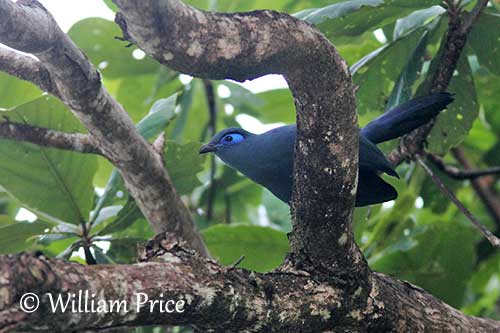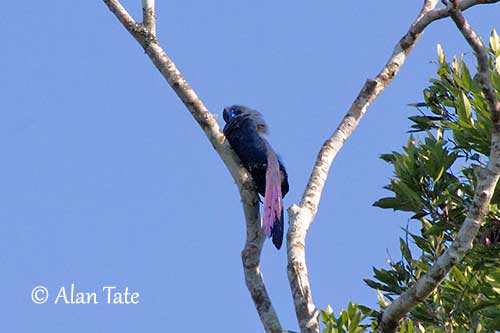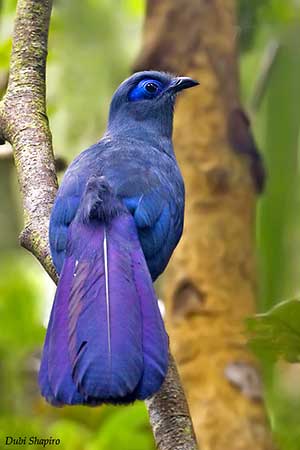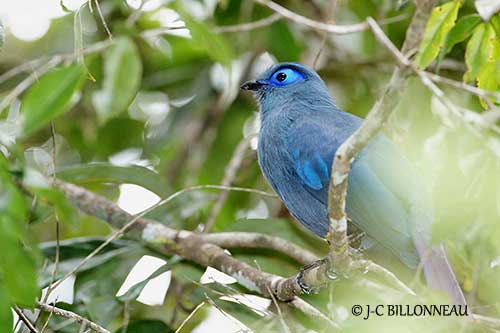
Fr: Coua bleu
Ang: Blue Coua
All: Blau-Seidenkuckuck
Esp: Cúa Azul
Ita: Cua blu
Nd: Blauwe Coua
Sd: blåkoua
Mal: fandrasa, Mariha, Taitso, Taitso mainty, Taitso manga
Photographers:
Jean-Claude Billonneau
Photographe-témoin de la Beauté du Monde
William Price
PBase-tereksandpiper & Flickr William Price
Dubi Shapiro
Dubi Shapiro Photo Galleries
Alan & Ann Tate
AA Bird Photography
Text by Nicole Bouglouan
Sources:
HANDBOOK OF THE BIRDS OF THE WORLD vol 4 by Josep del Hoyo-Andrew Elliott-Jordi Sargatal - Lynx Edicions - ISBN: 8487334229
Cuckoos of the World Par Johannes Erritzøe, Clive F. Mann, Frederik Brammer, Richard A. Fuller – Editeurs A&C Black, 2012 – ISBN: 1408142678, 9781408142677
The Cuckoos Par Robert B. Payne – Editeur : OUP Oxford, 2005 – ISBN : 0191513555, 9780191513558
The Birds of Africa: Volume VIII: The Malagasy Region: Madagascar, Seychelles, Comoros, Mascarenes - Par Roger Safford, Frank Hawkins – ISBN: 1408190494, 9781408190494- Editeur: A&C Black, 2013
Wikipedia, the free encyclopaedia
THE AVIANWEB - Beauty of Birds (Sibylle Faye)
CREAGUS@Monterey Bay (Don Roberson)
Blue Coua
Coua caerulea
Cuculiformes Order – Cuculidae Family
INTRODUCTION:
The Blue Coua is endemic to Madagascar where it frequents forests and mangroves in E and NW of the island.
It feeds on insects, small reptiles and fruits, mainly found from treetops to undergrowth, and very rarely on the ground. It is mostly arboreal and occurs usually in midstorey.
The Blue Coua is not a parasitic cuckoo. It builds its own nest and rears its young.
This species is described as common in suitable habitats, but it is hunted for food by local people, and its range is affected by habitat destruction. But currently, it is not globally threatened.
RANGE:
The Blue Coua is found in most of E and NW Madagascar.
HABITAT:
The Blue Coua frequents the primary rainforest, the second growth, deciduous forest and mangroves. It is also present in plantations such as clove (Syzygium aromaticum) and cacao (Theobroma cacao). It usually avoids the dry forest. It can be seen from sea-level to 1,800 metres of elevation, but it is commonest below 1,200 metres in SE Madagascar.
CALLS AND SONGS: SOUNDS BY XENO-CANTO
The Blue Coua produces unmelodious sounds. It gives a short, trilled “brrreee-ee” increasing in volume. It also utters low-pitched “coy coy coy coy” similar to Crested Coua but louder and lower. We can hear some grunts “kroo kroo” and a short, rasping, often repeated “karr-ow” with accented first syllable.
BEHAVIOUR IN THE WILD:
The Blue Coua feeds on various insects such as cicadas, locusts, crickets, bees, beetles, flies, caterpillars and millipedes, and also spiders.
But its diet also includes chameleons, crabs, frogs, fruits and flowers. It takes gum resin from trees Sloana rhodantha.
The Blue Coua is an arboreal species. It hunts by inspecting the foliage for prey. It is active from treetops to undergrowth, but it occurs mainly in midstorey. It hops and runs on branches with the tail raised. It comes rarely to the ground where it runs sometimes.
It is usually seen alone or in pairs, and in small family parties after the breeding season.

The courtship displays are poorly known. The male performs courtship feeding like most Cuculidae. However, we can suggest that the long blue tail with violet sheen is spread and raised, and the conspicuous, bright-coloured head pattern is probably enhanced by adapted postures.
During the courtship feeding, the male holds a prey while spreading both wings and tail, and it bows. They are probably monogamous.
The Blue Coua is resident with some seasonal movements between humid and adjacent littoral forests.
It moves from tree to tree or crosses an opening by flying from high perch and gliding lower to the next one. It appears clumsy in flight.

DESCRIPTION OF THE BIRD:
Biometrics:
Length: 48-50 cm
Weight: M: 225-255 g – F: 240-268 g
The Blue Coua is a large bird with dark blue plumage overall. Wings and tail have violet sheen.
On the blue head, we can see a short crest. The eye is surrounded by bare skin, from cobalt-blue to violet.
The bill is black. The eyes are brown to reddish-brown. Legs and feet are blackish.
Male and female are similar.
The juvenile has sooty-black back, rump and lower belly. The wings are dull blue and the tail lacks the violet iridescence. The skin around the eye is feathered, not bare.

REPRODUCTION OF THIS SPECIES:
The breeding season takes place between July and December, mainly during the rainy season. The laying occurs in November.
The Blue Coua builds a nest and does not parasitize those of other species. It is a bowl-shaped structure made with sticks, placed in dense foliage between 3,5 and 10 metres above the ground.
The female lays a single white egg, and both adults share the incubation and feed the young with insects.
Incubation and nestling periods are currently unknown.
PROTECTION / THREATS / STATUS:
The Blue Coua is common in suitable habitat. It is locally hunted for food, and its forest habitat has become degraded. However, it survives in second growth. It is present in several protected areas and within intact forest.
The size of the population is unknown, but it is suspected to be stable.
The Blue Coua is currently evaluated as Least Concern.
